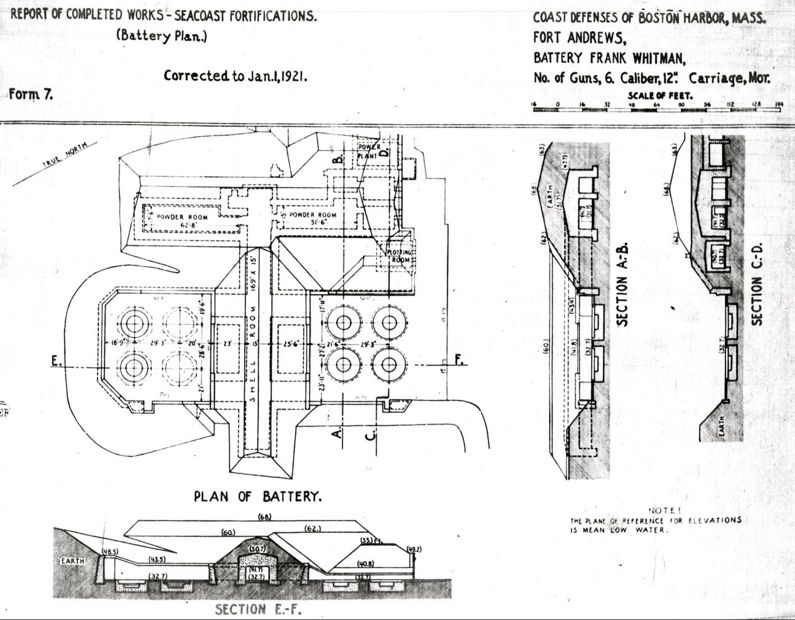Battery Whitman
|
Battery Whitman (1902-1942) - Battery Frank Whitman was a reinforced concrete, Endicott Period 12 inch coastal mortar battery on Fort Andrews (1), Plymouth County, Massachusetts. The battery was named in G.O. 20, 25 Jan 1906 after Major Frank H. Whitman, 20th Kansas Volunteer Infantry (Captain, 2nd U.S. Infantry), who served with distinction during the Spanish-American War and the insurrection in the Philippine islands, and who died 7 Aug 1904. Battery construction started in 1898, was completed in 1901 and transferred to the Coast Artillery for use 15 Jan 1902 at a cost of $ 86,000. Deactivated in 1942. Endicott PeriodPart of the Harbor Defense of Boston, Massachusetts. Originally built as an Endicott Period concrete coastal mortar battery with eight 12" M1890MI mortars mounted on M1890 mortar carriages. This was a single story mortar battery with two mortar pits and four mortars in each pit. The mortar pits were separated by earth covered concrete magazines on the same level as the mortar loading platform. Electrical power for the battery was furnished by an emplacement power plant in the adjacent Battery Cushing. The mortars were serviced from the magazine using shot carts to move the heavy mortar shells from the magazine entrance to the mortars. These mortar pits were designed to be salvoed with all four mortars fired at the same time and aimed in parallel, so as to produce a bracketing fire on the target. In practice, they were seldom all fired at once because of the terrific concussion. The original battery was "remodeled" in the period 1909-1913 and, during the remodeling, significant changes were made in the armament of the Battery. The first action was the transfer of four mortars and carriages in Pit A to Battery Geary, Fort Mills, in the Philippine Islands on 16 Nov 1910. In 1913 four M1908 mortars and carriages were transferred to Battery Whitman to be remounted in place of the mortars sent to the Philippines.

World War IThe U.S. entry into World War I resulted in a widespread removal of large caliber coastal defense gun tubes for service in Europe. Many of the gun and mortar tubes removed were sent to arsenals for modification and mounting on mobile carriages, both wheeled and railroad. Most of the removed gun tubes never made it to Europe and were either remounted or remained at the arsenals until needed elsewhere. Two M1890MI mortars were ordered dismounted for shipment on 3 May 1918. Both mortars were transferred to Morgan arsenal on 4 Jun 1918 and they were not replaced in Battery Whitman. At some point after 1921, Battery Whitman and Battery Cushing became known as Battery Cushing-Whitman and is referred to in this manner in World War II project plans. World War IIBattery Whitman was obsolete at the beginning of World War II and it was deactivated in 1942. The order to dispose of the armament was dated 6 Nov 1942 and the gun cards record the order to scrap the mortars and the carriages on 15 Dec 1942. This action was a part of a mass disposal of mortar batteries in the fall of 1942 that was a part of the first large scale, quota driven, World War II scrap drive. Current StatusNo period guns or mounts in place.
Sources:
Links: Visited: No
| ||||||||||||||||||||||||||||||||||||||||||||||||||||||||||||||||||||||||||||||||||||||||||||||||||||||||||||||||||||||||||||||||||||||||||||||||||||||||||||||||||||||||||||||||||||||